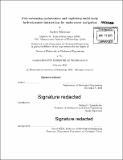Fish swimming optimization and exploiting multi-body hydrodynamic interactions for underwater navigation
Author(s)
Maertens, Audrey (Audrey Paulette Solange)
DownloadFull printable version (25.59Mb)
Other Contributors
Massachusetts Institute of Technology. Department of Mechanical Engineering.
Advisor
Michael S Triantafyllou.
Terms of use
Metadata
Show full item recordAbstract
When walking, driving or riding a bicycle, we mostly rely on vision to avoid obstacles and evaluate optimal paths. Underwater, vision is usually limited, but flow structures resulting from the hydrodynamic interactions between inert and/or living bodies contain rich information, which fish can read through a dedicated sensory system, the lateral line. Fish can even extract energy from these flow features. Immersed Boundary Methods (IBMs) are particularly well suited to simulate flows resulting from several moving bodies. In this thesis, the difficulty of most existing IBMs to accurately handle Reynolds numbers higher than 103 is discussed, and a second order boundary treatment that significantly improves the accuracy at intermediate Reynolds number (10³ < Re < 10⁵) is presented. Using this new numerical method, object identification using a lateral line is first investigated. It is shown that the boundary layer of a gliding fish can amplify the hydrodynamic disturbance due to a nearby obstacle and thus help object detection and identification. With their lateral line, fish can also identify coherent structures in turbulent flow and measure flow features generated by their own swimming motion. In particular, fish have been shown to use their lateral line as a feedback sensor to optimize their motion in both turbulent and quiescent flow. Two mechanisms by which fish can minimize the energy expanded when swimming are presented: gait optimization and schooling. The Strouhal number, pitch angle and angle of attack at the tail are identified as the key parameters determining swimming efficiency in quiescent flow. By optimizing the undulatory gait, a quasi-propulsive efficiency of 57% is attained for a foil undulating in open-water (34% for a fish) at Reynolds number Re = 5000. Fish often travel in schools, and it is shown that significant energy savings are possible by exploiting energy from coherent turbulent flow structures present in fish schools. By properly timing its motion, a foil undulating in the wake of an other foil can reach an efficiency of 80%.
Description
Thesis: Ph. D., Massachusetts Institute of Technology, Department of Mechanical Engineering, 2015. Cataloged from PDF version of thesis. Includes bibliographical references (pages 145-159).
Date issued
2015Department
Massachusetts Institute of Technology. Department of Mechanical EngineeringPublisher
Massachusetts Institute of Technology
Keywords
Mechanical Engineering.